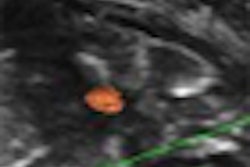Myocardial perfusion echocardiography with contrast can improve the sensitivity of dobutamine stress tests in detecting coronary artery disease (CAD) and also improve the performance of treadmill exercise stress echocardiography, according to a study published online in Heart.
The researchers found that real-time perfusion imaging with continuous infusion of microbubble contrast significantly increased the sensitivity of dobutamine stress echocardiography compared to only performing wall-motion analysis. And the technique turned in even better results when used in treadmill exercise stress echocardiography exams.
"During both [dobutamine stress echocardiography] and [treadmill exercise stress echocardiography], the sensitivity of [wall-motion] analysis during [real-time perfusion] imaging is improved because subendocardial wall-thickening abnormalities can be detected," wrote a team led by Dr. Saritha Dodla of the University of Nebraska Medical Center in Omaha.
The researchers wanted to determine the incremental value of real-time perfusion imaging during treadmill exercise echocardiography in assessing myocardial perfusion and contrast-enhanced wall motion, and compare it to the performance of dobutamine stress echocardiography conducted over the same period. The study team retrospectively reviewed 254 patient studies from December 2005 to February 2008. All patients had quantitative angiography within 90 days of the stress test or were considered not to have CAD based on previously established criteria (Heart, August 26, 2009).
During the study period, 155 patients being examined for the presence of significant CAD received real-time perfusion imaging with dobutamine stress echocardiography, while 99 had real-time perfusion imaging with treadmill stress echocardiography. Patients received the Definity ultrasound contrast agent (Lantheus Medical Imaging, North Billerica, MA), and real-time perfusion imaging was performed on either a Sonos 5500 (Philips Healthcare, Andover, MA) or an Acuson Sequoia C512 scanner (Siemens Healthcare, Malvern, PA).
Contrast replenishment, plateau intensity, and wall motion were all examined for the detection of CAD.
During dobutamine stress echocardiography, myocardial perfusion imaging with real-time perfusion was better at detecting CAD, yielding a sensitivity of 85%, significantly better than the 72% turned in when using wall-motion analysis to find CAD (p < 0.05).
"The improvement in sensitivity with [myocardial perfusion] analysis during [dobutamine stress echocardiography] was primarily due to better detection of left anterior descending disease," the authors wrote.
Myocardial perfusion imaging with real-time perfusion showed even more value for detecting CAD during treadmill exercise stress echocardiography, producing 98% sensitivity and a statistically significant improvement versus when the technique was used in dobutamine stress echocardiography (p < 0.05). The study team also found that wall-motion sensitivity during treadmill exercise echocardiography had an 89% sensitivity in detecting CAD, significantly better than wall-motion sensitivity during dobutamine stress echocardiography (p < 0.05).
The improvement in wall-motion sensitivity during treadmill exercise stress echocardiography was due to the detection of subendocardial wall-thickening abnormalities in 48% of the patients with induced subendocardial perfusion defects, according to the study team.
"Large prospective clinical trials are needed to confirm that [real-time perfusion] improves [wall-motion] sensitivity during [treadmill exercise stress echocardiography] and [dobutamine stress echocardiography], by comparing the [wall-motion] sensitivity during [real-time perfusion] with that achieved during conventional harmonic imaging, where ultrasound contrast is currently used only to improve endocardial border delineation," the authors concluded. "Such trials are under way."
By Erik L. Ridley
AuntMinnie.com staff writer
September 14, 2009
Related Reading
Exercise echo predicts cardiac events in diabetics, June 24, 2009
Cardiac elastography technique shows promise, May 22, 2009
Echocardiography predicts heart disease mortality when ECG does not, May 22, 2009
New echocardiography tool offers rapid, accurate assessment of LV function, May 12, 2009
ACC study documents echo contrast safety in critically ill patients, March 31, 2009
Copyright © 2009 AuntMinnie.com




















